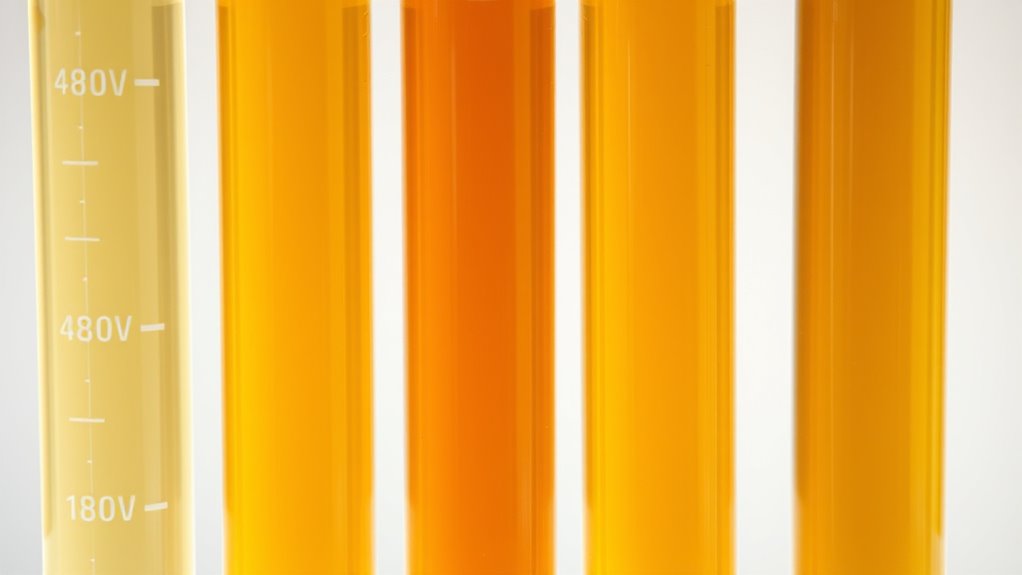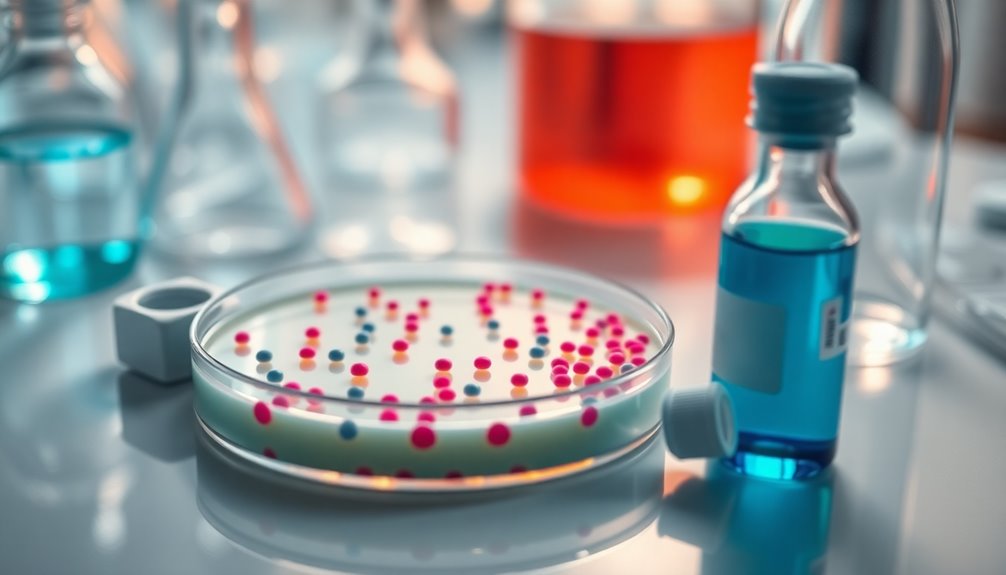Your urine color offers important clues about your health and hydration. Clear or pale yellow urine usually means you’re well-hydrated and your kidneys are working properly. Dark yellow, amber, or deep amber can signal dehydration, while bright yellow suggests vitamin intake. Unusual colors like red, brown, or cloudy urine might point to infections, liver issues, or other health concerns. Pay attention to these signs; if you want to understand what they mean, keep exploring this topic.
Key Takeaways
- Clear, pale yellow urine indicates good hydration and proper kidney function, while dark yellow suggests dehydration.
- Bright yellow often reflects vitamin intake, especially B-complex supplements, and generally signals metabolic health.
- Darker or amber urine can point to dehydration or mild health issues requiring increased fluid intake.
- Red, brown, or tea-colored urine may signal bleeding, liver problems, or other serious health conditions needing medical attention.
- Unusual colors like green or blue can result from medications, infections, or rare disorders, indicating potential health concerns.
The Significance of Clear and Pale Yellow Urine

Clear and pale yellow urine typically indicates that you are well-hydrated and your kidneys are functioning properly. When your urine appears this way, it means you’re drinking enough water to keep your body balanced and your kidneys efficiently removing waste. Staying properly hydrated helps prevent infections, kidney stones, and other health issues. It also ensures your body’s systems operate smoothly, supporting digestion, circulation, and temperature regulation. If your urine remains consistently light and clear, it’s a good sign you’re maintaining healthy fluid intake. However, if it becomes overly clear or diluted, it might suggest you’re drinking excessive water, which can sometimes lead to other health concerns. Overall, clear or pale yellow urine is a positive indicator of good hydration and kidney health. Adequate hydration supports all these bodily functions and promotes overall well-being.
Understanding Dark Yellow or Amber Urine
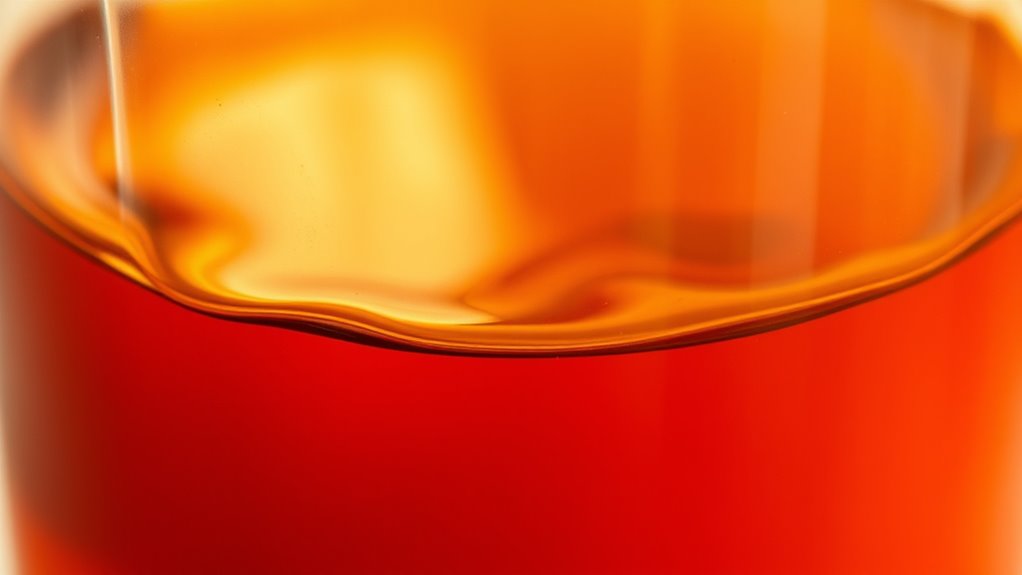
Dark yellow or amber urine often signals that your body is conserving water and may be slightly dehydrated. This coloration occurs when urine is more concentrated due to reduced fluid intake or increased fluid loss. It’s your body’s way of signaling you to drink more water. To better understand, here’s a quick guide:
| Urine Color | Possible Cause | Recommended Action |
|---|---|---|
| Clear/Pale | Well-hydrated | Maintain current fluid intake |
| Dark Yellow | Mild dehydration | Increase water consumption |
| Amber | Moderate dehydration | Drink more fluids |
| Deep Amber | Severe dehydration | Seek medical attention |
| Brownish | Liver issues | Consult a healthcare provider |
Monitoring your urine color helps you stay aware of hydration needs and overall health. Being mindful of hydration levels can prevent the progression to more severe dehydration and associated health issues.
What Bright Yellow Urine Indicates

Bright yellow urine often indicates that your body is efficiently processing vitamins, especially B-complex supplements like riboflavin. When you take these vitamins, they’re quickly absorbed and excreted through urine, giving it a vivid yellow hue. This vibrant color usually signals that your hydration level is adequate and your kidneys are functioning well. It’s a positive sign that your body is absorbing and eliminating nutrients effectively. Additionally, color accuracy in urine can reflect how well your body maintains proper metabolic functions. However, if your urine remains consistently bright yellow without supplement intake, it could suggest high vitamin consumption or dehydration. Keep an eye on your overall hydration and diet, but bright yellow urine alone isn’t usually a cause for concern. It simply reflects your body’s active vitamin metabolism and proper hydration status.
The Meaning of Orange-Hued Urine
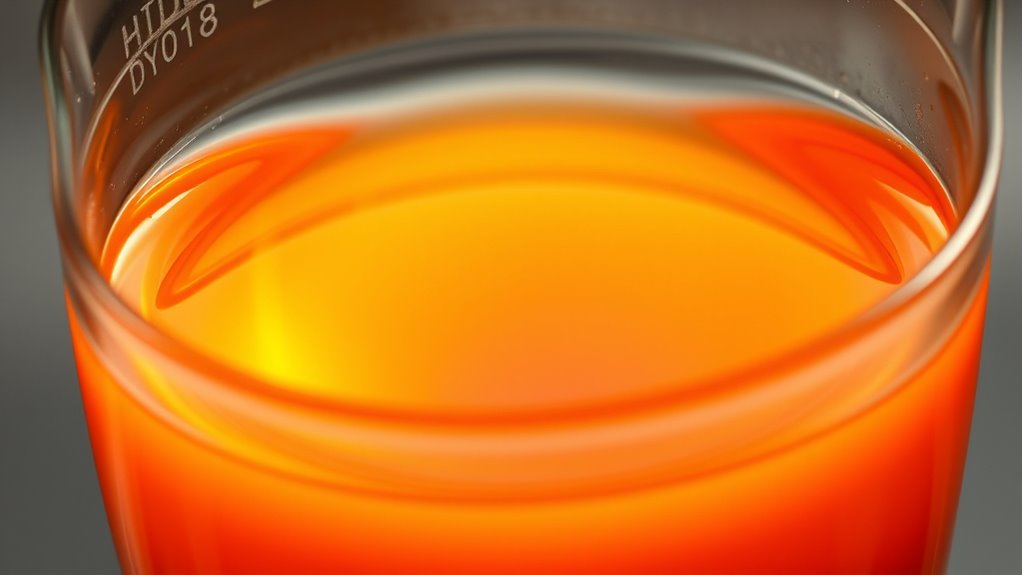
Orange-hued urine can often signal that your body is processing excess vitamins or certain medications. B vitamins, especially B2 (riboflavin), and medications like phenazopyridine or warfarin can turn your urine bright or dark orange. This color change isn’t usually a concern, but it indicates your body is excreting high levels of these substances. If you’ve recently taken supplements or medications, this hue is likely temporary. However, persistent orange urine without explanation might suggest dehydration or liver issues, as the liver processes waste products. Staying well-hydrated can help dilute your urine and reduce the intensity of the color. Understanding your body’s processes can help you interpret these signs more accurately. If the orange tint continues or is accompanied by other symptoms like pain or fatigue, consult your healthcare provider for further evaluation.
Interpreting Pink or Red Tints in Urine
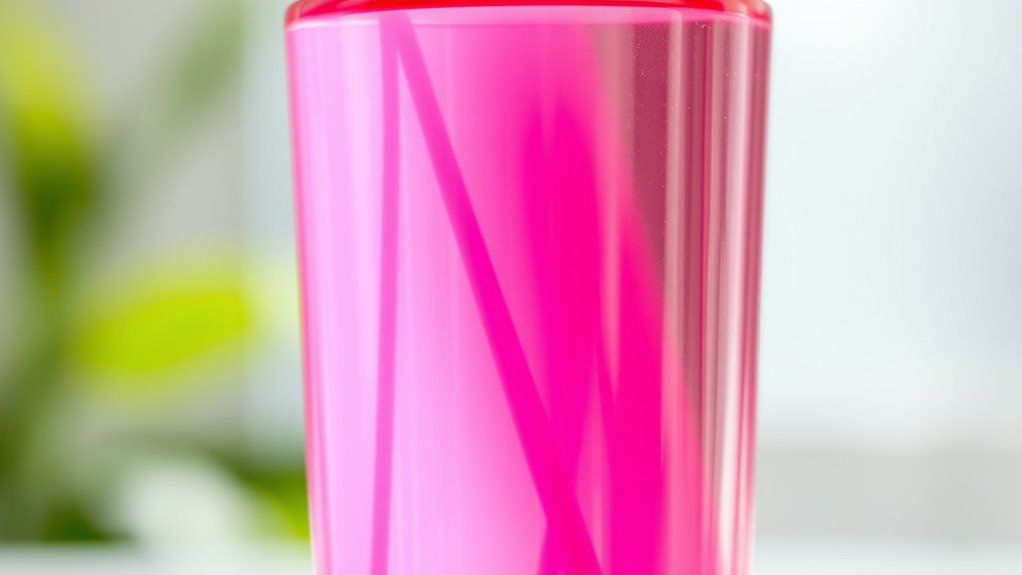
When you notice pink or red tints in your urine, it often signals the presence of blood, which can stem from a variety of causes. You might see a faint pink hue after intense exercise, or a more vivid red if there’s bleeding somewhere in your urinary tract. To understand the cause, consider these possibilities:
- Injury or trauma – a hit to your kidneys or bladder.
- Infections – urinary tract infections causing inflammation.
- Kidney stones – sharp, painful stones scraping along your urinary tract.
- Menstrual cycle – blood mixing with urine during your period.
If blood persists or you’re unsure, it’s essential to consult a healthcare professional for proper diagnosis and treatment.
When Urine Turns Brown or Tea-Colored
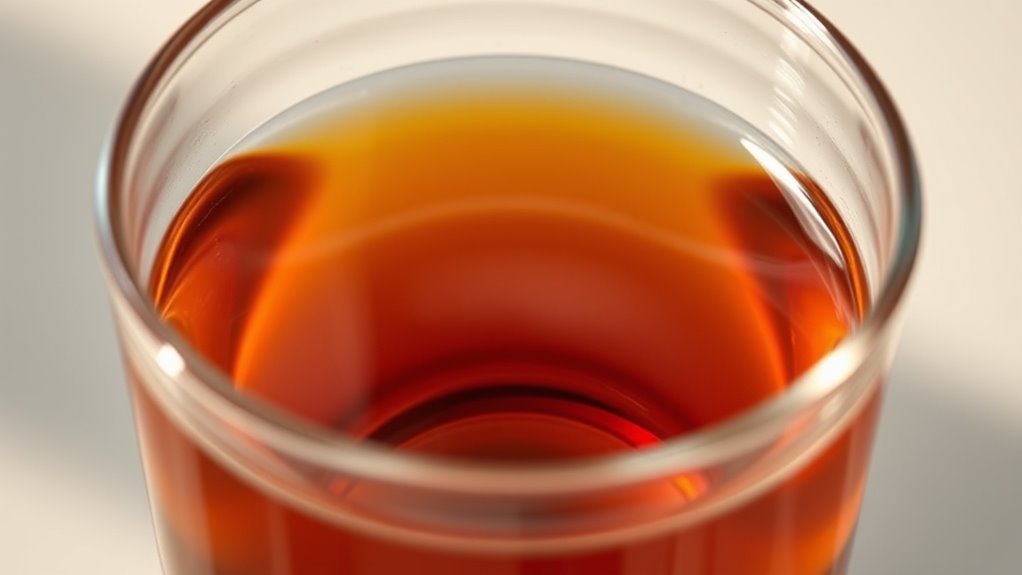
If your urine turns brown or tea-colored, it could signal liver problems or dehydration. These changes may indicate your body needs urgent medical attention. Don’t ignore these signs—it’s better to get checked out promptly. Persistent changes in urine color can also be a symptom of underlying health conditions, including liver issues.
Possible Liver Issues
A sudden change in urine color to brown or tea-colored can indicate liver problems, especially if you also notice symptoms like fatigue, jaundice, or abdominal pain. Your liver processes toxins and produces bile, which affects urine color. When liver function is impaired, bilirubin can build up and spill into your urine, turning it darker. Imagine:
- The rich hue of brewed tea swirling in your urine.
- A dark, almost cola-like shade signaling possible trouble.
- A sudden, noticeable change from your usual pale straw color.
- The color deepening after periods of fatigue or discomfort.
- Recognizing liver function signs can help prompt early medical intervention.
If your urine takes on this darker tone along with other symptoms, it’s essential to seek medical advice promptly. Early detection can help address potential liver issues before they worsen.
Dehydration Risks Increase
Dehydration often causes urine to turn darker, taking on shades of brown or tea-colored. When your body lacks enough water, your kidneys conserve fluid by producing concentrated urine. This dark hue signals you’re not drinking enough, increasing dehydration risks. If ignored, dehydration can lead to dizziness, fatigue, and even kidney issues. To understand better, consider the following:
| Urine Color | Hydration Level |
|---|---|
| Light yellow | Well-hydrated |
| Dark yellow | Mild dehydration |
| Brown/tea | Severe dehydration, risk of complications |
Staying hydrated helps flush toxins and supports overall health. Drinking enough water regularly prevents your urine from darkening and keeps dehydration risks at bay. Hydration is essential for maintaining optimal bodily functions and preventing health complications.
Seek Medical Attention
When your urine turns brown or tea-colored, it’s a clear sign that you should seek medical attention promptly. This change could indicate serious health issues, such as liver problems or dehydration. To help visualize, consider these signs:
- You notice dark, almost cola-like urine in the toilet.
- It persists despite drinking water.
- You experience yellowing of your skin or eyes.
- You feel unusually fatigued or have abdominal pain.
- Changes in urine color may also be linked to liver function and other vital health processes.
Don’t ignore these symptoms—they could signal liver disease, bile duct blockages, or other critical conditions. Prompt medical evaluation ensures proper diagnosis and treatment. Early intervention can prevent complications and restore your health. Trust your body’s signals and seek help when urine color alarms you.
The Implication of Green or Blue Tinted Urine
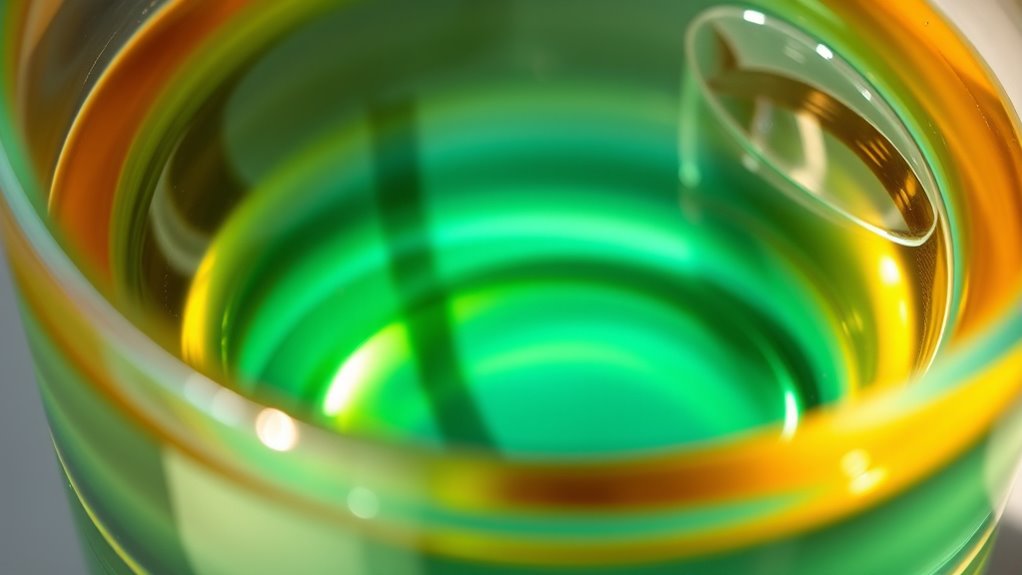
Green or blue urine can be be caused by certain medications, dyes, or supplements you might be taking. Sometimes, it signals underlying health issues that need attention. If your urine stays this color without explanation, you should consult a healthcare professional promptly. Understanding early signs of health issues can help you seek timely medical care and ensure your well-being.
Possible Causes of Color
Green or blue-tinted urine can be surprising and may indicate the presence of certain medical conditions or external factors. You might notice this unusual color after specific activities or medication use. Here are some possible causes:
- Medications – Certain drugs like amitriptyline or methylene blue can turn your urine a vivid blue or green hue.
- Foods and Supplements – Consuming foods with artificial dyes or taking supplements like spirulina can tint urine bright colors.
- Infections – Rare urinary tract infections caused by bacteria such as Pseudomonas can produce a greenish coloration.
- Medical Conditions – Genetic disorders like porphyria or metabolic issues may result in abnormal urine colors.
- AI-Related Safety Concerns – As AI technology advances, understanding potential security vulnerabilities helps in maintaining safe health data management.
Understanding these causes helps you identify whether the color change is harmless or warrants further investigation.
When to Seek Medical Help
Although vibrant urine colors can sometimes result from harmless factors like medications or foods, it’s important to recognize when they may signal a medical issue. Green or blue-tinted urine can be caused by certain dyes, medications, or supplements, but persistent or sudden changes should raise concern. If you notice these colors alongside symptoms like pain, fever, or difficulty urinating, seek medical attention promptly. These unusual hues could indicate infections, liver problems, or reactions to medication. Don’t ignore persistent discoloration, especially if it’s accompanied by other symptoms. Early diagnosis and treatment are crucial to address underlying health issues and prevent complications. When in doubt, consult a healthcare professional to evaluate your symptoms and determine the appropriate course of action.
Factors That Cause Cloudy or Murky Urine

Cloudy or murky urine can result from a variety of factors, often indicating underlying health issues or temporary conditions. You might notice this change after certain activities or due to health concerns. Here are some common causes:
- Infections – Urinary tract infections can introduce bacteria, pus, or blood, giving urine a cloudy appearance.
- Dehydration – When you’re dehydrated, your urine becomes concentrated, sometimes appearing cloudy.
- Kidney Stones – Small stones can cause irritation, leading to cloudy urine with possible blood traces.
- Diet and Supplements – Consuming high levels of certain vitamins or foods can alter urine clarity temporarily.
If cloudy urine persists, consult a healthcare professional to rule out serious conditions.
How Dehydration Affects Urine Color

When you’re dehydrated, your body conserves water by producing more concentrated urine, which directly affects its color. Instead of clear or light yellow, your urine turns darker, often a deep amber or honey shade. This signals that your body needs fluids to stay properly hydrated. To help you recognize these signs, here’s a quick comparison:
| Hydrated Urine | Dehydrated Urine |
|---|---|
| Clear or light yellow | Dark amber or honey |
| Indicates good hydration | Indicates dehydration |
If your urine darkens, it’s a clear sign you should drink more water. Staying hydrated keeps your urine lighter and helps flush out toxins, supporting overall health.
Recognizing Urine Colors That Warrant Medical Attention

You should pay attention if your urine turns dark, as it can signal dehydration or more serious issues. Bright yellow urine might be normal, but any sudden change warrants a closer look. Red or brown tints could indicate blood or liver problems and need prompt medical evaluation.
Dark Urine Risks
Dark urine can be a sign that your body is trying to tell you something serious, especially if it persists or worsens. It might indicate dehydration, liver problems, infections, or other health issues. Ignoring these signs can lead to severe complications. Here are some warning signs to watch for:
- Deep amber or brownish hue that doesn’t fade with hydration
- Strong, foul odor indicating infection or liver issues
- Cloudiness or presence of blood suggesting infection or injury
- Persistent darkening despite drinking plenty of water
If you notice these signs, seek medical attention promptly. Dark urine isn’t just a cosmetic issue—it can point to underlying health problems that need diagnosis and treatment. Don’t ignore persistent symptoms; early intervention can prevent complications.
Bright Yellow Concerns
Bright yellow urine is typically considered normal, especially if you’re well-hydrated. However, if your urine appears intensely bright or neon yellow, it could indicate dehydration or excessive intake of certain vitamins, like B vitamins. While usually harmless, persistently bright yellow urine combined with symptoms like dizziness, weakness, or dry mouth warrants medical attention. It might also signal issues with your liver or kidneys, especially if accompanied by darkening or other abnormal signs. Don’t ignore sudden changes in color that don’t resolve with hydration. If your urine stays unnaturally bright despite drinking plenty of fluids, or if you experience additional symptoms, consult a healthcare professional. Recognizing these signs early helps ensure any underlying health issues are addressed promptly.
Red or Brown Tints
Red or brownish urine can signal serious health issues that require prompt medical attention. You should seek help if your urine looks like:
- Dark red or crimson—like fresh blood, indicating possible bleeding in the urinary tract or kidneys.
- Rusty or cola-colored—resembling dark tea, which may point to liver problems or hematuria.
- Deep brown—similar to muddy water, possibly signaling liver disease or bile duct blockages.
- Clumpy or cloudy tints—accompanied by a foul odor, suggesting infection or kidney stones.
These colors aren’t normal and could be signs of underlying health conditions. Don’t ignore these signs—consult a healthcare professional promptly to identify and treat the root cause.
Frequently Asked Questions
Can Urine Color Indicate Specific Vitamin Deficiencies?
You might wonder if urine color reveals vitamin deficiencies. While bright yellow urine often indicates adequate B vitamin intake, darker or unusually colored urine can sometimes signal deficiencies or dehydration. However, urine color alone isn’t a reliable indicator of specific vitamin deficiencies, as many factors influence it. If you’re concerned about your vitamin levels, it’s best to consult a healthcare professional and get proper tests rather than rely solely on urine color.
How Does Medication Affect Urine Color Changes?
Ever wondered if your medication turns your pee into a neon sign? Well, it can! Some drugs, like vitamins, antibiotics, or laxatives, change your urine color to bright yellow, orange, or even green. This isn’t magic, just chemistry at work. So, next time your bathroom visits resemble a paint palette, don’t panic—your meds are just showing off a little. Always check with your doctor if you’re concerned.
Is Urine Color Linked to Mental Health or Stress Levels?
You might wonder if your urine color reflects mental health or stress levels. While there’s no direct link, dehydration caused by stress can darken your urine. Stress may also impact your hydration habits, leading to changes in urine color. However, urine color alone isn’t a reliable indicator of mental health. Staying hydrated, managing stress, and seeking professional help are better steps to support your mental well-being.
Can Urine Color Reveal Underlying Kidney Problems?
You might wonder if urine color can reveal kidney problems. Bright or dark amber urine, especially if it’s concentrated or persistent, can indicate dehydration or kidney issues. Cloudy or foamy urine might suggest infection or protein buildup. If you notice these changes regularly, it’s important to see a healthcare professional. They can perform tests to diagnose kidney problems early and recommend appropriate treatment, ensuring your kidneys stay healthy.
Does Hydration Status Influence Urine Odor Alongside Color?
Ever notice how your urine’s smell can change? You might think it’s just about the color, but hydration plays a big role too. When you’re well-hydrated, your urine stays clear and odorless. Dehydration concentrates your urine, making it smell stronger and darker. Ironically, by simply drinking more water, you can keep both the color and smell in check, turning a potentially embarrassing situation into a sign of good health.
Conclusion
By paying attention to your urine color, you can catch potential health issues early. If your urine isn’t clear or pale yellow, or if it changes color unexpectedly, it might be time to see a doctor. Remember, your urine is a window into your overall health—so don’t ignore what it’s telling you. Isn’t it worth taking a quick look and staying proactive about your well-being?
